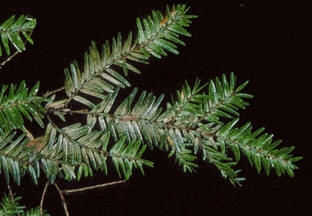Spruce Spider Mite
 DESCRIPTION
DESCRIPTION
Spruce Spider Mites are considered to be the most destructive spider mites in the United States. This species attacks Spruce, Juniper, Arborvitae, Hemlock, Pine, Douglas Fir and occasionally other conifers. Spruce trees seem to be their favorite host plants. The adults are about 1/2 mm long. Eggs are oval to circular and reddish-brown.
LIFE CYCLE
Spruce Spider Mites overwinter as eggs tucked in and around bud scales and at the base of needles. These hatch in the Spring, usually before growth starts. The young pale green mites resemble adults except they are smaller and have only three pairs of legs. As the mites mature, they shed their skin three times before becoming adults. Adults have four pairs of legs and are dark green to nearly black with the body surface clothed with salmon-pink colored spines. Legs of the adults are also salmon-pink. A generation from egg to adult may require 15-20 days and generations frequently overlap so that all stages can be found on host plants throughout the Summer. There are 7-10 generations produced each year.
DAMAGE
Spruce Spider Mites damage host plants by sucking plant sap from the needles as they feed. Infested trees initially have a speckled- yellowish appearance, and lack rich green color. After prolonged feeding, needles turn rusty colored and may drop prematurely. Mites usually attack older needles located in the lower and inner parts of the tree. Damage spreads toward the tree top as the season progresses. Spruce Spider Mites also produce silken webs on the needles.
 MONITORING & DETECTION
MONITORING & DETECTION
When plant foliage begins to show off-green color and mites are suspected, make a foliage check. Take a piece of white paper, hold it under a branch suspected of having mites and strike the branch hard against the paper. This should dislodge the mites, and even though they are only 1/50th of an inch long, you should be able to see the dark oval mites against the white background. Check 3-4 places around the tree. If you dislodge 10 or more mites at each site, it would be advisable to apply a control measure.
CONTROL
Formulations of horticultural spray oil, insecticidal soap and several miticides are labeled for Spruce Spider Mite control.* Apply a registered formulation to kill mites hatching from eggs. If mite populations persist, repeat applications (alternating the material used) may be necessary. Monitor mite populations prior to applying a control measure. Follow all label directions for specific information on host plant label clearance, phytotoxicity information, safety precautions and dosage information.
* See Woody Ornamental Insect, Mite and Disease Management, The Pennsylvania State University (2005) for more details.
WARNING: Pesticides are poisonous. Read and follow directions and safety precautions on labels. Handle carefully and store in original labeled containers out of reach of children, pets and livestock. Dispose of empty containers right away , in a safe manner and place. Do not contaminate forage, streams or ponds.
For professional assistance with tree and shrub problems, contact a Keystone arborist
Penn State Fact Sheet on Spruce Spider Mite


